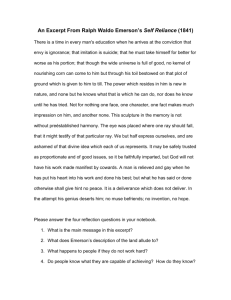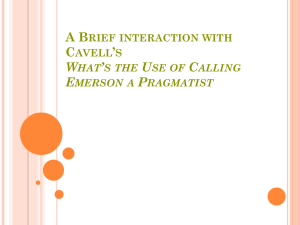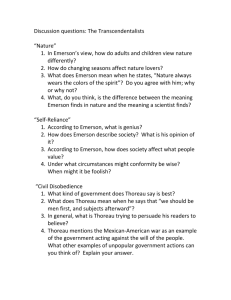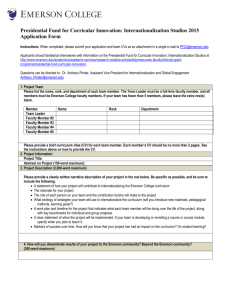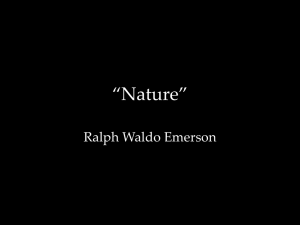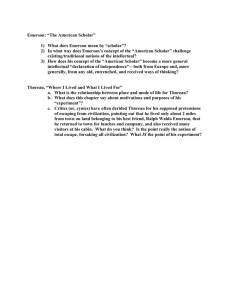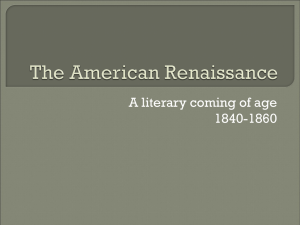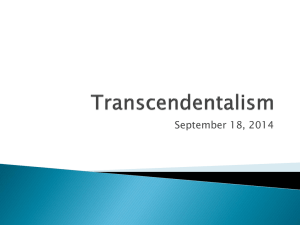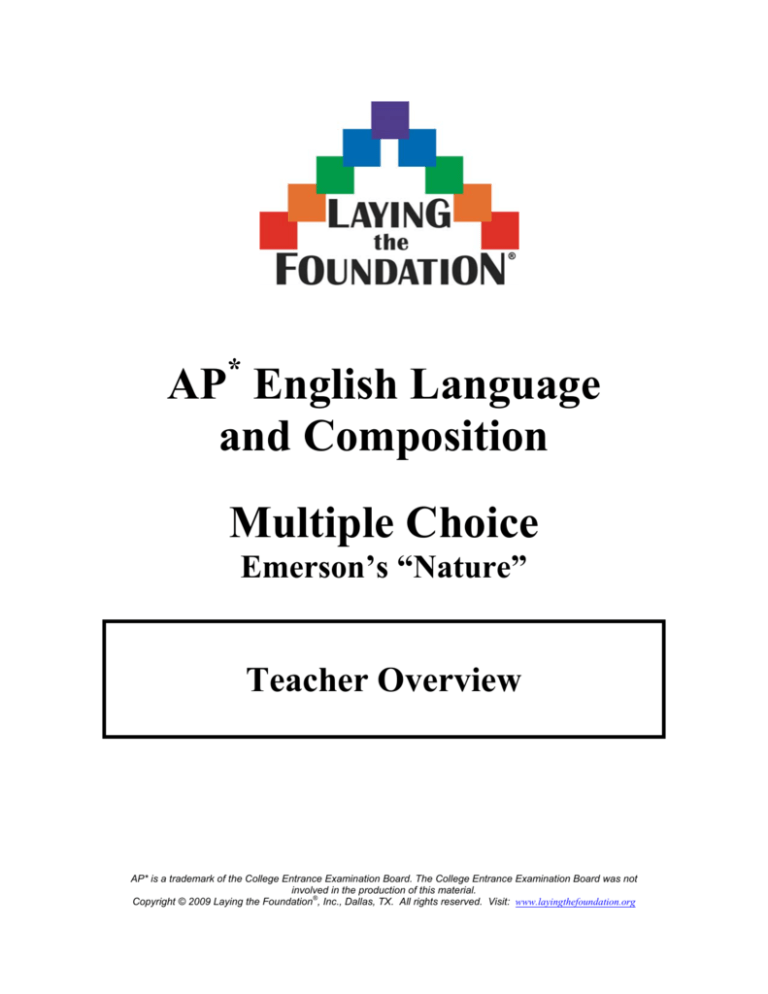
*
AP English Language
and Composition
Multiple Choice
Emerson’s “Nature”
Teacher Overview
AP* is a trademark of the College Entrance Examination Board. The College Entrance Examination Board was not
involved in the production of this material.
®
Copyright © 2009 Laying the Foundation , Inc., Dallas, TX. All rights reserved. Visit: www.layingthefoundation.org
Multiple Choice
Ralph Waldo Emerson’s “Nature”
Teacher Overview
Levels of Thinking
Remember
Understand
Close Reading
Reading Strategies
Annotation
Determining Author’s Purpose
Determining Main Idea
Generalization
Inference
Literary Elements
Character
antagonist/protagonist
motivation
Detail
Diction
connotation
denotation
Imagery
Mood
Plot
conflict
suspense
Point of View
person
perspective
Style
Theme
Tone
tone determined through
diction, imagery, detail,
point of view, figurative
language, author’s style,
and syntax
Figures of Speech (Figurative
Language)
Metaphor
Personification
Simile
Literary Techniques
Characterization
direct
indirect
Hyperbole (Overstatement)
Irony
Satire
Understatement
Apply
Analyze
Grammar
Evaluate
Create
Composition
Phrases
Participial
Clauses
Dependent/Subordinate
expletives
Independent
Sentence Variety
Sentence Beginnings
Sentence Combining
Syntax Techniques
Juxtaposition
Omission
asyndeton
ellipsis
Parallelism
Polysyndeton
Rhetorical Fragment
AP* is a trademark of the College Entrance Examination Board. The College Entrance Examination Board was not
involved in the production of this material.
®
Copyright © 2009 Laying the Foundation , Inc., Dallas, TX. All rights reserved. Visit: www.layingthefoundation.org
1
Teacher Overview—Emerson’s “Nature” Multiple Choice
Materials: Copies of this lesson. The final page of the lesson is designed to be taken out
and used for later review. Instructions for the teacher appear in blue italics.
Introduction: Test Structure
Section I of the Advanced Placement* English exam is the multiple choice section. This
section is 60 minutes long and consists of about 55 questions. The reading represents a
variety of modes – AP Language: narration, argumentation, persuasion, description; AP
Literature: poetry and prose, both fiction and nonfiction. The selections will vary in
length from about 300 words to 700 words.
Each selection is followed by 12 to 15 multiple choice questions based on content and
style. The line-referenced questions will follow the order of the selections, but
interspersed among them will be questions which cover the entire passage. The selection
will give you everything you need to answer the questions, so it’s up to you to read
carefully and think critically. You are not expected to have prior knowledge about the
selection’s content.
Use your knowledge of your own strengths and weaknesses to form your strategy for
getting the most correct answers you possibly can. By analyzing the questions you get
wrong on practice tests and by determining why you missed them, you can begin to reach
some understanding:
• Do you read the stems too quickly?
• Do you misread the choices and especially the correct ones?
• Is one certain question type the hardest for you?
• Can you see why the correct answer is better than your choice of a wrong answer?
®
Copyright © 2009 Laying the Foundation , Inc., Dallas, TX. All rights reserved. Visit: www.layingthefoundation.org
2
Teacher Overview—Emerson’s “Nature” Multiple Choice
Activity One: Read the excerpt from Ralph Waldo Emerson’s “Nature” and answer the
questions that accompany the text.
This is intended to be a guided practice to work on as a larger group with the class.
To speak truly, few adult persons can
see nature. Most persons do not see the sun. At
least they have a very superficial seeing. The
sun illuminates only the eye of the man, but
5
shines into the eye and the heart of a child. The
lover of nature is he whose inward and outward
senses are still truly adjusted to each other; who
has retained the spirit of infancy even into the era
of manhood. His intercourse with heaven and
10
earth, becomes part of his daily food. In the
presence of nature, a wild delight runs through
the man, in spite of real sorrows. Nature says, -he is my creature, and maugre all his impertinent
griefs, he shall be glad with me. Not the sun or
15
the summer alone, but every hour and season
yields its tribute of delight: for every hour and
change corresponds to and authorizes a different
state of the mind, from breathless noon to
grimmest midnight. Nature is a setting that fits
20
equally well a comic or a mourning piece. In
good health, the air is a cordial of incredible
virtue. Crossing a bare common, in snow
puddles, at twilight, under a clouded sky, without
having in my thoughts any occurrence of special
25
good fortune, I have enjoyed a perfect
exhilaration. I am glad to the brink of fear. In
the woods too, a man casts off his years, as a
snake his slough, and at what period soever of
life, is always a child. In the woods, is perpetual
30
youth. Within these plantations of God, a
decorum and sanctity reign, a perennial festival
is dressed, and the guest sees not how he should
tire of them in a thousand years. In the woods,
1. According to Emerson, why do most people only
superficially see the sun? Most people only acknowledge the
concrete (the heat, the light). They do not “see” clearly
enough to experience the joy in nature and in all its elements.
They do not acknowledge the connection between human
beings and every part of the natural world, including the sun.
2. How does Emerson define “the lover of nature”? One
whose inward and outward senses are truly adjusted to each
other. He believes that a lover of nature experiences the
world with his senses and also with his spirit.
3. What might he mean by “the spirit of infancy”? The spirit
of infancy is a way of looking at the world with innocence and
a childlike openness to what it has to offer.
4. Identify the metaphor in line 10. What is being compared?
“…daily food” is the metaphor. The communion with nature
is compared to food because to Emerson such communion is
as necessary to the survival of the soul as is food to the body.
5. In context, what might “maugre” mean? Think of a
synonym to replace it. “maugre” means “in spite of” or
“notwithstanding.”
6. What is the antecedent of “he” in line 13? Man
7. What is the effect of personifying Nature in lines 12-14?
Nature becomes an entity with which man can have a
relationship. Nature is alive and real and dynamic, as if it
were a person.
8. In lines 14-19, Emerson employs what rhetorical device to
reveal the breadth of nature? Antithesis is the device. The
juxtaposition of opposites highlights the broad spectrum of
everything in nature.
9. “Nature is a setting that fits equally well a comic or a
mourning piece.” What does Emerson mean? Do you agree?
Nature is the perfect place for man to exercise his heroism
and survives in spite of his flaws. Answers will vary.
10. What does it mean “to be glad to the brink of fear”?
What rhetorical device is employed in this expression?
Both hyperbole and paradox are used in this phrase.
Emerson suggests that the intense experience of communing
with nature is both exhilarating and terrifying.
11. In the sentence in line 11, what words would normally be
considered contradictory to “special good fortune” (line 2425). “bare,” “puddles,”” twilight,” and “cloudy”
12. Explain the analogy of lines 27-28. Man sheds his way of
looking at nature with jaded, limited vision for a new way that
is innocent and childlike. This casting off of the old for the
new is repeated unceasingly throughout the natural world.
13. “Child” and “youth” are motifs representing what idea in
this paragraph? A perspective, and an attitude toward nature,
open and unlimited.
we return to reason and faith. There I feel that
®
Copyright © 2009 Laying the Foundation , Inc., Dallas, TX. All rights reserved. Visit: www.layingthefoundation.org
3
Teacher Overview—Emerson’s “Nature” Multiple Choice
35
nothing can befall me in life, -- no disgrace, no
calamity, (leaving me my eyes,) which nature
cannot repair. Standing on the bare ground, -my head bathed by the blithe air, and uplifted
14. Of all things that might befall Emerson, what is the
one calamity that nature could not repair? Why would
such a loss be devastating? He could not recover from
the loss of his eyesight because it is through the sense
of sight that he experiences nature and maintains the
relationship with it.
into infinite space, -- all mean egotism vanishes.
40
I become a transparent eye-ball; I am nothing; I
see all; the currents of the Universal Being
circulate through me; I am part or particle of
God. The name of the nearest friend sounds then
foreign and accidental: to be brothers, to be
45
15. Discuss the paradoxes in lines 40-46. “ I am
nothing-I see all.” “The name of the nearest friend
sounds foreign.” “To be brothers…is a trifle”. What
he means here is that to see nature in a new way makes
the familiar now new and different. In addition, he
loses his individual identity but in becoming a part of
the whole, he gains understanding.
acquaintances, -- master or servant, is then a
trifle and a disturbance. I am the lover of
uncontained and immortal beauty. In the
wilderness, I find something more dear and
connate than in streets or villages. In the tranquil
50
landscape, and especially in the distant line of
the horizon, man beholds somewhat as beautiful
as his own nature.
The greatest delight which the fields
and the woods minister, is the suggestion of an
55
occult relation between man and the vegetable. I
am not alone and unacknowledged. They nod to
me, and I to them. The waving of the boughs in
the storm, is new to me and old. It takes me by
surprise, and yet is not unknown. Its effect is
60
16. Define the word “occult” as it is used in line 55.
The most appropriate denotation is “supernatural” or
“mysterious.”
17. What is the antecedent for “it” in the last two
sentences? “The waving of the boughs” is the
grammatical antecedent but it represents the
relationship or the communion between man and
nature.
18. What is the main idea of the last paragraph? The
relationship Emerson has with nature changes the way
he sees everything in his life. It makes him a better
man
like that of a higher thought or a better emotion
coming over me, when I deemed I was thinking
justly or doing right.
®
Copyright © 2009 Laying the Foundation , Inc., Dallas, TX. All rights reserved. Visit: www.layingthefoundation.org
4
Teacher Overview—Emerson’s “Nature” Multiple Choice
Activity Two: Multiple Choice Questions
Read the passage, then answer the following multiple choice questions. You will have
sixteen (16) minutes.
Time the students. It is your option whether or not to allow them to use their notes
from the previous activity, depending upon their skill level. When time is up, have
them score their own papers and discuss the rationales for the correct answers.
5
10
15
20
25
30
To speak truly, few adult persons can
see nature. Most persons do not see the sun. At
least they have a very superficial seeing. The
sun illuminates only the eye of the man, but
shines into the eye and the heart of a child. The
lover of nature is he whose inward and outward
senses are still truly adjusted to each other; who
has retained the spirit of infancy even into the era
of manhood. His intercourse with heaven and
earth, becomes part of his daily food. In the
presence of nature, a wild delight runs through
the man, in spite of real sorrows. Nature says, -he is my creature, and maugre all his impertinent
griefs, he shall be glad with me. Not the sun or
the summer alone, but every hour and season
yields its tribute of delight: for every hour and
change corresponds to and authorizes a different
state of the mind, from breathless noon to
grimmest midnight. Nature is a setting that fits
equally well a comic or a mourning piece. In
good health, the air is a cordial of incredible
virtue. Crossing a bare common, in snow
puddles, at twilight, under a clouded sky, without
having in my thoughts any occurrence of special
good fortune, I have enjoyed a perfect
exhilaration. I am glad to the brink of fear. In
the woods too, a man casts off his years, as a
snake his slough, and at what period soever of
life, is always a child. In the woods, is perpetual
youth. Within these plantations of God, a
decorum and sanctity reign, a perennial festival
®
35
40
45
50
55
60
is dressed, and the guest sees not how he should
tire of them in a thousand years. In the woods,
we return to reason and faith. There I feel that
nothing can befall me in life, -- no disgrace, no
calamity, (leaving me my eyes,) which nature
cannot repair. Standing on the bare ground, -my head bathed by the blithe air, and uplifted
into infinite space, -- all mean egotism vanishes.
I become a transparent eye-ball; I am nothing; I
see all; the currents of the Universal Being
circulate through me; I am part or particle of
God. The name of the nearest friend sounds then
foreign and accidental: to be brothers, to be
acquaintances, -- master or servant, is then a
trifle and a disturbance. I am the lover of
uncontained and immortal beauty. In the
wilderness, I find something more dear and
connate than in streets or villages. In the tranquil
landscape, and especially in the distant line of
the horizon, man beholds somewhat as beautiful
as his own nature.
The greatest delight which the fields
and the woods minister, is the suggestion of an
occult relation between man and the vegetable. I
am not alone and unacknowledged. They nod to
me, and I to them. The waving of the boughs in
the storm, is new to me and old. It takes me by
surprise, and yet is not unknown. Its effect is
like that of a higher thought or a better emotion
coming over me, when I deemed I was thinking
justly or doing right.
Copyright © 2009 Laying the Foundation , Inc., Dallas, TX. All rights reserved. Visit: www.layingthefoundation.org
5
Teacher Overview—Emerson’s “Nature” Multiple Choice
1. Which of the following best describes the way the passage is narrated?
(A) The reader’s perspective is limited to Emerson’s point of view.
(B) The reader views the scene through a child’s perspective.
(C) The narrator makes his comments relate to the moral significance of events.
(D) The narrator changes the point of view throughout the passage.
(E) The narrator maintains an ironic distance from the reader.
A.
The point of view of the passage is first person, with the narrator, Emerson,
expressing his opinion on nature. Since in an essay the author is the narrator, the
message contains Emerson’s own views.
B.
Although Emerson mentions that the sun shines “into the eye and the heart of a
child” (line 5), the reader does not have to adopt a child’s point of view to understand
the passage.
C.
Although Emerson deals with his views of nature, these views do not illustrate
whether nature is particularly good or bad.
D.
Since Emerson uses the first person pronoun “I” throughout the passage, no
change in point of view occurs.
E.
While Emerson wants the reader to understand his views, and frequently uses
figurative language to enlighten, he does not try to distance himself or use irony, the
opposite of what he means.
2. The style of the passage is
(A) simple and learned
(B) lyrical and vacillating
(C) reflective and relaxed
(D) indifferent and intricate
(E) scholarly and philosophical
A.
The language definitely is learned, or scholarly (e.g. “superficial” [line 3],
“maugre” [line 13], “exhilaration” [line 26], “decorum” [line 31]). Therefore, also
calling the language “simple” would be a contradiction.
B.
The diction is lyrical, being subjective and sensual, as revealed with the clause “I
have enjoyed a perfect exhilaration” (line 25-26). Just as the diction remains lyrical,
without vacillating, or changing, so Emerson’s effusive view of nature remains constant.
C.
Although Emerson is reflecting on his ideas about nature, his diction is formal
and learned, not relaxed and casual.
D.
Although Emerson’s style is intricate and involved, he is not indifferent to his
subject. Instead, he has definite, consistently positive views about nature.
E.
Emerson’s style is learned or scholarly, containing formal, complex diction and
syntax. He also provides his philosophical views on nature (e.g. “I become a
transparent eye-ball; I am nothing; I see all; the currents of the Universal Being
circulate through me; I am part or particle of God” [lines 40 – 43]).
®
Copyright © 2009 Laying the Foundation , Inc., Dallas, TX. All rights reserved. Visit: www.layingthefoundation.org
6
Teacher Overview—Emerson’s “Nature” Multiple Choice
3. The author supports his views primarily through the use of
(A) antithesis
(B) syllogisms
(C) definitions
(D) logical appeals
(E) historical allusions
A.
In much of the excerpt, Emerson makes antithetical statements. For example,
he states, “The waving of the boughs . . . is new to me and old” (lines 57 – 58), then
concludes the passage with “It takes me by surprise, and yet is not unknown” (lines 58
– 59).
B.
A syllogism is a form of deductive reasoning consisting of a major premise, a
minor premise, and a conclusion. No syllogisms are evident in this excerpt.
C.
Emerson does not attempt to define nature or its components; he simply outlines
his passionate views on the subject.
D.
Emerson reveals his own subjective feelings about nature but never uses logic to
try to persuade readers of his opinions. No objective facts or statistics occur in the
passage. He even states that “In the woods, we return to reason and faith” (line 34).
E.
Emerson does not allude to historical events.
4. Which of the following best summarizes the author’s attitude in lines 5 – 10?
(A) Cynicism prevents humans from understanding nature.
(B) Only puerile minds indulge in contemplative fantasy.
(C) Reminiscence of childhood helps adults appreciate nature.
(D) Only juvenile minds can cherish the wonders of nature.
(E) Self-absorbed people take nature too much for granted.
A.
A cynic is scornful of the motives of others. Emerson describes a lover of nature
as a person whose senses are “truly adjusted” (line 7) and one who keeps the spirit of the
infant as an adult. This kind of person communes with heaven and earth and is filled
with a “wild delight” (line 11). Such an attitude is not cynical but is instead enthusiastic
and joyful.
B.
The word “puerile” means childish. Emerson comments that a lover of nature
retains the “spirit of infancy” (line 8), but he does not imply that the adult nature-lover is
childish and immature.
C.
When an adult “has retained the spirit of infancy” (line 8), he recalls and
appreciates the joys of nature he found as a child.
D.
Emerson states that “few adult persons can see nature” (line 1 - 2); he does not
claim that all adults lack the vision.
E.
Although self-absorbed people may well take nature for granted because they may
not observe its wonders, Emerson suggests that people should find their “inner child”
and discover the joys of nature.
®
Copyright © 2009 Laying the Foundation , Inc., Dallas, TX. All rights reserved. Visit: www.layingthefoundation.org
7
Teacher Overview—Emerson’s “Nature” Multiple Choice
5. As used in line 13, “maugre” means
(A) however
(B) owing to
(C) therefore
(D) as a result of
(E) notwithstanding
A.
By inserting “however” for “maugre” (line 13), the wording becomes “he is my
creature, and however all his impertinent griefs, he shall be glad with me.” This does
not make sense.
B.
If the wording is changed to “he is my creature, and owing to all his impertinent
griefs, he shall be glad with me,” the sense is lost.
C.
If the wording is changed to “he is my creature, and therefore all his impertinent
griefs, he shall be glad with me,” the words become confusing.
D.
Confusion results if the wording is changed to “he is my creature, and as a result
of all his impertinent griefs, he shall be glad with me.” Griefs rarely cause someone to
be glad.
E.
The word “notwithstanding” means in spite of. If the wording is changed to
“notwithstanding,” the meaning becomes clear (“he is my creature, and in spite of all
his impertinent griefs, he shall be glad with me”).
6. The juxtaposition of “breathless noon” (line 18) and “grimmest midnight” (line
19)
(A) creates doubt about the total wonder of nature
(B) stresses the diverse facets of nature
(C) emphasizes man’s obsession with time
(D) reiterates the prior illumination imagery
(E) connotes a subtle ambiguous tone
A.
The references to “noon” (line 18) and “midnight” (line 19) reinforce the idea
that “every hour and season yields its tribute of delight” (lines 15 – 16). Emerson
reveals his total wonder of nature, never doubting it.
B.
Nature presents many different ways to delight man—from the awe-stricken
“breathless noon” (line 18) to the shocking “grimmest midnight” (line 19). Emerson
then states “Nature is a setting that fits equally well a comic or a mourning piece”
(lines 19 – 20)
C.
Although Emerson uses “noon” (line 18) and “midnight” (line 19) as examples of
two very opposite moments in a day, he does not show that man is obsessed with the
concept of time.
D.
Although Emerson mentions the “sun” (line 14) before he introduces the bright
imagery associated with a “breathless noon” (line 18), he does not repeat the dark
imagery associated with “grimmest midnight” (line 19).
E.
Emerson’s tone is not ambiguous. He stresses that “every hour and season yields
its tribute of delight” (lines 15 – 16). From “breathless noon to grimmest midnight”
(line 18 – 19), Emerson delights in every aspect of nature.
®
Copyright © 2009 Laying the Foundation , Inc., Dallas, TX. All rights reserved. Visit: www.layingthefoundation.org
8
Teacher Overview—Emerson’s “Nature” Multiple Choice
7. The sentence in lines 22 – 26 (“Crossing a bare common . . . a perfect
exhilaration.”) contains all the syntactical elements EXCEPT
(A) parallel construction
(B) prepositional phrases
(C) simple sentence structure
(D) periodic sentence structure
(E) cumulative sentence structure
A.
Parallel construction, a repeated grammatical construction, occurs with all the
prepositional phrases.
B.
Prepositional phrases occur in the words “in snow puddles” (line 22 – 23), “at
twilight” (lines 23), “under a clouded sky” (line 23), “without having in my thoughts”
(line 23 – 24).
C.
A simple sentence consists of one independent clause with one subject and one
verb. Although it may have many phrases, it will not contain any dependent clauses.
Because this sentence fits this description, it is simple.
D.
In a periodic sentence, the independent clause comes at the end after an
accumulation of phrases and/or dependent clauses. This sentence follows this pattern,
ending with the main clause “I have enjoyed a perfect exhilaration” (line 25 – 26).
E.
In a cumulative sentence, the essential meaning is complete before the end with
the independent clause coming at the beginning. This syntax pattern does not occur
here.
8. The metaphorical description of a festival (lines 31 – 32) suggests that
(A) nature is an ethereal final resting place
(B) men who revel in the occult prefer such decorum
(C) nature contributes diverse agricultural benefits
(D) men who appreciate nature do not find it tiresome
(E) nature supports vast realms of social and spiritual conviviality
A.
A “perennial festival” (line 31) is present in all seasons of the year or persists for
several years. The word “perennial” (line 31) suggests nature’s lasting forever, not
dying or being in a “final resting place.”
B.
Although the words “occult” (line 55) and “decorum” (line 31) appear in the
passage, the description does not show any relationship between the supernatural and
polite behavior. The two terms do not fit together.
C.
Although Emerson mentions “fields” (line 53) and “the vegetable” (line 55), he
does not discuss any agricultural benefits.
D.
Emerson shows that in the woods, a “perennial festival” (line 31) exists, one
that lasts. He also states that the “guest sees not how he should tire of them [a reign of
decorum and sanctity] in a thousand years” (line 32 – 33). People who love nature do
not grow tired of it.
E.
Emerson reveals that the commune with nature is an individual experience, not a
social one: “The name of the nearest friend sounds then foreign and accidental” (lines
43 – 44) and “to be acquaintances . . . is then a trifle and a disturbance” (lines 44 – 45).
®
Copyright © 2009 Laying the Foundation , Inc., Dallas, TX. All rights reserved. Visit: www.layingthefoundation.org
9
Teacher Overview—Emerson’s “Nature” Multiple Choice
9. Which of the following pairs of words function as opposites in the passage?
I. “impertinent” (line 13) and “glad” (line 14)
II. “decorum” (line 31) and “sanctity” (line 31)
III. “reason” (line 34) and “faith” (line 34)
(A) I only
(B) III only
(C) I and II only
(D) II and III only
(E) I, II and III
I.
The word “impertinent” (line 13) means to exceed the limits of manners; to be
“glad” (line 14) implies happiness. The words do not function as opposites.
II.
The word “decorum” (line 31) refers to appropriately polite behavior; the word
“sanctity” (line 31) refers to the condition of being considered sacred. The words do not
function as opposites.
III.
The word “reason” (line 34) refers to rational, logical, or analytical thought; the
word “faith” (line 34) implies a confident belief in something. The two words function as
opposites; therefore, “III. only” makes up the correct response.
10. Through context in lines 47 – 49, “In the wilderness, I find something more dear
and connate than in streets or villages,” the word “connate” most likely means
(A) abstruse
(B) restrained
(C) discordant
(D) revered
(E) arcane
A.
In the context, Emerson describes the wilderness as beautiful and “tranquil” (line
49). The word “abstruse,” meaning mysterious and incomprehensible, would not fit
here.
B.
The word “restrained,” meaning held back, would not fit within the context of the
passage when Emerson states that he is “the lover of uncontained and immortal beauty”
(lines 46-47).
C.
The word “discordant” means out of harmony, especially in sound, a negative
connotation. The wilderness is “dear” to Emerson, not negative in any way.
D.
If something is dear, it most likely is “revered” or adored. This word fits the
context well, as Emerson loves nature and the wilderness.
E.
If something is arcane, it is secret or hard to understand. In the wilderness,
Emerson finds something that is more “dear” (line 48) to him than what he finds in
villages. Emerson does not mention that the wilderness is difficult to understand.
®
Copyright © 2009 Laying the Foundation , Inc., Dallas, TX. All rights reserved. Visit: www.layingthefoundation.org
10
Teacher Overview—Emerson’s “Nature” Multiple Choice
11. The effect of the personification in lines 56-57 is to
(A) illustrate the narrator’s rather unearthly link to nature
(B) reflect the surprising relationship between fields and woods
(C) outline the powerful aesthetic principals of the natural world
(D) demonstrate the extraordinary effects of ministering to vegetables
(E) reveal the narrator’s surprise when he communes with occult beings
A.
When Emerson states that the vegetables “nod” (line 56) to him and that he
nods back to them, he personifies the vegetables. The branches also wave to him in the
storm. He is illustrating his link to the vegetation.
B.
Emerson suggests “an occult relation between man and the vegetable” (line 55).
He does not mention the link between vegetation and woods.
C.
Aesthetics is characterized by an increased sensitivity to beauty. The vegetation
may nod to the narrator; however, an increased sensitivity to the beauty of the scene is
not present.
D.
Vegetables are not being ministered to through the personification. Man and
vegetable are acknowledging one another, illustrating the link between the two.
E.
Surprise overtakes the narrator as he recognizes the link between man and
vegetation. He is not communicating or communing with the occult.
12. The antecedent of “it” in the clause “Its effect is like that of a higher thought”
(lines 59-60) is
(A) “waving” (line 57)
(B) “boughs” (line 57)
(C) “storm” (line 58)
(D) “surprise” (line 59)
(E) “effect” (line 59)
A.
Emerson writes “The waving of the boughs in the storm, is new to me and old.
It [the waving] takes me by surprise (lines 58 – 59).” He then states “Its effect [the
waving] is like that . . . .” (line 59 – 60). The antecedent of “It” (line 58) and of “Its”
(line 59) is “waving” (line 57).
B.
Emerson refers to the waving of the boughs and that their waving takes him “by
surprise” (line 58 – 59). The boughs do not surprise him.
C.
The storm does not take Emerson by surprise; the waving of the branches does.
D.
In saying that the effect of the surprise “is like that of a higher thought or a better
emotion” (line 59 – 60), the meaning of the statement is lost. Emerson says that the
effect of the waving is like a higher thought to him.
E.
The word “effect” is somewhat redundant and does not make sense as the
antecedent. The sentence would then mean “The effect of the effect is like that of a
higher thought . . . .”
®
Copyright © 2009 Laying the Foundation , Inc., Dallas, TX. All rights reserved. Visit: www.layingthefoundation.org
11
Teacher Overview—Emerson’s “Nature” Multiple Choice
13. An example of inversion occurs with the words
(A) “To speak truly, few adult persons can see nature” (line 1)
(B) “In the woods too, a man casts off his years” (lines 26 – 27)
(C) “In the woods, is perpetual youth” (lines 29 – 30)
(D) “There I feel that nothing can befall me” (lines 34 – 35)
(E) “Its effect is like that of a higher thought” (lines 59 – 60)
A.
The subject of the sentence and its modifiers (“few adult persons” [line 1]) come
before the verb (“can see” [line 1 – 2]) and the object (“nature” [line 2]). The sentence
is in natural order.
B.
The subject of the sentence (“a man” [line 27]) comes before the verb (“casts off
[line 27]) and the object (“his years” [line 27]). The sentence is in natural order.
C.
The subject of the sentence and its modifier (“perpetual youth” [line 29 – 30])
come after the verb “is” (line 29). The sentence is in inverted order.
D.
Although the sentence begins with an adverb (“There” [line 34]), the subject and
verb are written in natural order.
E.
The subject (“effect” [line 59]) comes before the verb (“is” [line 59]),
demonstrating natural order.
14. The final paragraph presents an ironic juxtaposition of the
(A) lover of nature and the image of God
(B) eye of mankind and the heart of a child
(C) difference between youthfulness and old age
(D) relationship between human beings and vegetation
(E) nodding of the vegetation and the waving of the boughs
A.
Emerson does not place a lover of nature and an image of God side-by-side in the
final paragraph to produce a contrast. He talks about the link “between man and the
vegetable” (line55); Emerson does not relate this idea to God.
B.
The narrator does not deal with adults, children, and nature in the final
paragraph.
C.
Emerson deals with the link between man and vegetation in the final paragraph;
he does not deal with age.
D.
Emerson discusses “the suggestion of an occult relation between man and the
vegetable” (lines 54 – 55), the relationship between humans and vegetation.
E.
The vegetables and boughs are personified when they “nod” (line 33) and wave
to the narrator. No juxtaposition of contrasting ideas is present.
®
Copyright © 2009 Laying the Foundation , Inc., Dallas, TX. All rights reserved. Visit: www.layingthefoundation.org
12
Teacher Overview—Emerson’s “Nature” Multiple Choice
15. Wording that depicts both hyperbole and paradox are found in
(A) “The sun illuminates only the eye of the man” (line 4)
(B) “a wild delight runs through the man” (line 11)
(C) “I am glad to the brink of fear” (line 26)
(D) “I become a transparent eye-ball” (line 40)
(E) “I am not alone and unacknowledged” (lines 55 – 56)
A.
The statement contains understatement, not hyperbole, with “The sun illuminates
only the eye of the man” (lines 3 – 4) and does not illustrate a paradox.
B.
Although perhaps slightly exaggerated by the personification of “a wild delight”
(line 11) that is running, this statement is not paradoxical.
C.
The words “glad to the brink of fear” (line 26) are paradoxical because at first
glance the statement appears contradictory—how can someone be “glad” near “fear”?
On further examination, the meaning becomes clear—that it is an exaggeration, or
hyperbole, for effect. If a person is that happy, the situation may feel frightening.
D.
While this exaggerated statement is metaphorical, comparing Emerson to a
“transparent eye-ball,” (line 40), it does not reveal an ironic, contradictory situation.
E.
This sentence is an example of litotes, a double negative (“not . . .
unacknowledged” [lines 55 – 56]) that creates understatement for emphasis. No
hyperbole or paradox occurs.
16. The passage as a whole introduces contrasts between all of the following
EXCEPT
(A) incipience and antiquity
(B) pleasure and adversity
(C) plentitude and dearth
(D) known and unknown
(E) wilderness and metropolis
A.
The word “incipience” refers to a beginning versus “antiquity” or ancient times.
Emerson discusses the effect of the waving of the boughs as being “new to me and old”
(line 58).
B.
Emerson reveals a contrast between “pleasure” and “adversity” or suffering with
the words “a wild delight runs through the man, in spite of real sorrows” (line 11 – 12).
C.
Although nature may be viewed as containing abundance for the person who
loves being outside, Emerson does not deal with a “dearth” or scarcity as result of
nature’s grandeur.
D. Emerson reveals a contrast between the “known” and the “unknown” in the words
“It takes me by surprise, and yet is not unknown” (lines 58 – 59).
E. Emerson introduces a contrast between the “wilderness” and the “metropolis” in
the words “In the wilderness, I find something more dear and connate than in streets or
villages” (lines 48 – 49).
®
Copyright © 2009 Laying the Foundation , Inc., Dallas, TX. All rights reserved. Visit: www.layingthefoundation.org
13
Teacher Overview—Emerson’s “Nature” Multiple Choice
Activity Three: Justifying your answers: After checking your responses to the
questions with the key, identify two questions you missed. For these questions, write an
explanation of the correct response using text evidence in your explanation. Use
complete sentences.
Answers will vary. After you review the correct answers, have students work in small
groups or individually to complete this activity. When they have had adequate time to
complete the task, have them return to the larger class to discuss their findings.
I missed question # ____. I thought letter ____ was the answer, but I now realize letter
____ is a better choice because:
I missed question # ____. I thought letter ____ was the answer, but I now realize letter
____ is a better choice because:
®
Copyright © 2009 Laying the Foundation , Inc., Dallas, TX. All rights reserved. Visit: www.layingthefoundation.org
14
Teacher Overview—Emerson’s “Nature” Multiple Choice
Top Twenty Tips for Success
Be sure to review these with the students before the timed multiple choice activity.
1. Preview the test. Remember, passages are often repeated so you don’t have to turn back to
find an answer.
2. Decide where to begin. The test usually has 4 reading selections, but occasionally 5 will be
included. You don’t have to complete the first passage first, but be careful to mark your
answer document correctly. If 18th century poetry is difficult for you, for example, save it
for last.
3. Mark the time to start at the beginning of each passage (15 minutes for 4 passages in 60
minutes, or 12 minutes for 5 passages). Move on if you have spent too much time on one
section (over 15 minutes).
4. This is not a power test like the SAT®. Easy questions and very difficult questions are
mixed in with moderately difficult questions.
5. Read the passage and answer questions according to the divisions of the test. If you see
that three questions deal with the same paragraph, read that paragraph, answer those
questions, then move on to the next section.
6. This is not a homework assignment. You are not trying to remember information for future
reference. You are surfing for answers.
7. As you read the passages, anticipate questions. If you tend to read quickly, read the
question stems before you read the passage.
8. As you read the question stem, try to determine the answer before you read the choices.
9. Don’t guess unless you can eliminate two answers quickly. The guess penalty is ¼ point
for each incorrect answer.
10. Number the paragraphs in the prose passage.
11. Circle footnotes and titles.
12. Mark your answers in the margin on the test book.
13. Cross out incorrect answers to eliminate them from further consideration.
14. If you can’t decide between two answers, put a question mark in the margin and move on.
Come back to the question when you finish the section.
15. In line-reference questions, the answer may be before or after the line given, but questions
are focused on the quote in the line.
16. Remember that two answers are technically “correct,” but one answer is more focused and
to-the-point than the other.
17. Roman numeral questions are really nothing more than true/false questions. But they can
eat up your time. You may want to skip these questions if you’re short of time.
18. LEAST and EXCEPT questions are also time-consuming. Move on if they cause you to
stall out.
19. Keep your finger on the passage as you answer the questions, moving it down as you
continue to a new question. The line references are in order as they appear.
20. When you have finished a section (one passage), bubble in your Scantron. Don’t wait to
bubble until you have answered all the questions on the exam. You may run out of time.
Leave the most difficult questions until the end of each section. Sometimes a later question
can help to answer one previously encountered.
®
Copyright © 2009 Laying the Foundation , Inc., Dallas, TX. All rights reserved. Visit: www.layingthefoundation.org
15


